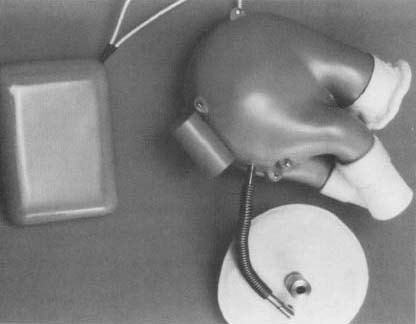Artificial heart
The heart functions primarily as a pump to keep blood circulating through the body. Because the heart's job is so repetitive, medical researchers have long considered developing a mechanical pump to replace it. In 1935 French surgeon Alexis Carrel (1873-1944) and famed American aviator Charles Lindbergh (1902-1974) designed a perfusion pump. The perfusion pump was designed to work outside of the human body. Its job was to keep unattached organs, including the heart, alive by circulating blood through them.
Early Developments
The first completely artificial heart (called a "TAH") was implanted in 1957 in a dog at the Cleveland Clinic. Willem Kolff, a Dutch-born surgeon, and T. Akutsu perforned the surgery. Kolff later led a medical team at the University of Utah at Salt Lake City in perfecting the artificial heart. In 1964 the National Institutes of Health established an Artificial Heart Program to develop both partial and total artificial heart devices.
Michael DeBakey (1908-) designed and implanted a pneumatically-driven (worked by air pressure) component called a Left Ventricular Assist Device (LVAD) in 1966. The LVAD served the chamber of the heart that pumps blood out into the arteries. Since the majority of severe heart disease is caused by left the ventricle failure, this was a major development.

Human Experimentation
The first implantation of an artificial heart in a human being was carried out in 1969. Denton Cooley (1920-) and his surgical team at the Texas Heart Institute performed the surgery. The pneumatically driven Dacronlined plastic heart used in the procedure had been designed by Argentineborn Domingo Liotta. Implanted as a temporary measure, its goal was to keep a cardiac patient alive until a heart transplant could be performed.
It wasn't until 1982 that the first artificial heart implant intended for permanent use was made. A surgical team headed by William DeVries at the University of Utah performed the procedure. Dentist Barney Clark made worldwide headlines when he was given a second chance for life with the Jarvik-7. The Jarvik-7 was designed by American physician Robert Jarvik. The device was a pump made of plastic and titanium powered by compressed air. The compressed air was delivered by a large external (outside) air compressor through two tubes that passed into the body via incisions in the abdomen. Clark survived the surgery for only 112 days.
DeVries then joined the staff at Humana Hospital in Louisville, Kentucky. At Humana he carried out four other Jarvik-7 implants during 1984 and 1985. Each of these patients also died, including William Schroeder. Schroeder survived 620 days, but suffered a long series of debilitating setbacks during that period. The results of actual permanent implantation of the Jarvik-7 revealed its limitations, including the fact that it caused blood clots to form that traveled to the brain and caused strokes.
Current research focuses on a new generation of electrically-powered artificial hearts. These devices use portable battery packs to transmit power via radio signals. The radio signals pass through unbroken skin to an implanted mechanical heart pump. This provides the patient with mobility and eliminates the need for permanent artificial openings in the body. It also reduces the possibility of infection, a problem that existed with the first air-powered heart. The first of these electric devices was experimentally implanted in a human subject in 1991.
[See also Barnard, Christiaan ; Transplant, surgical ]